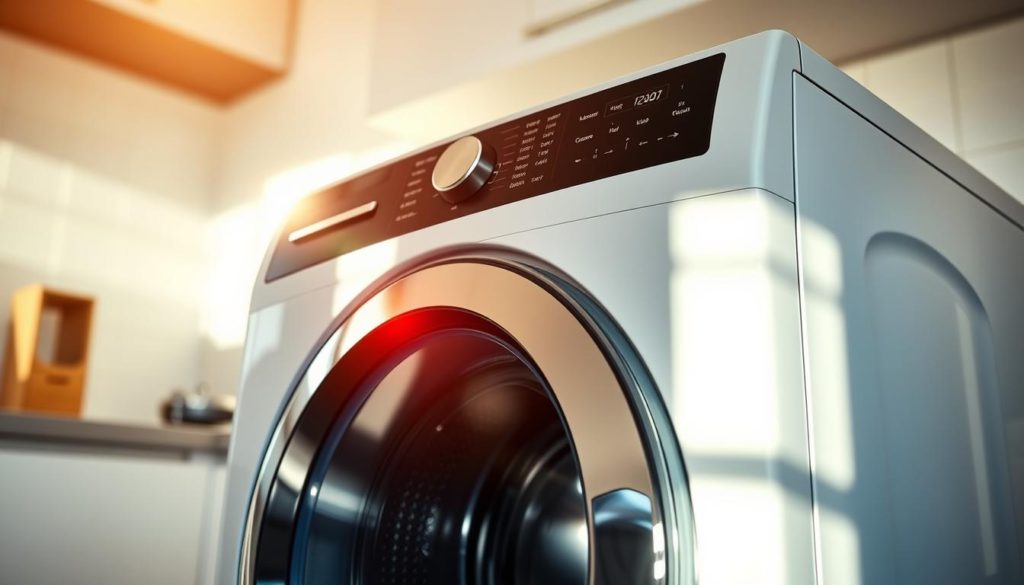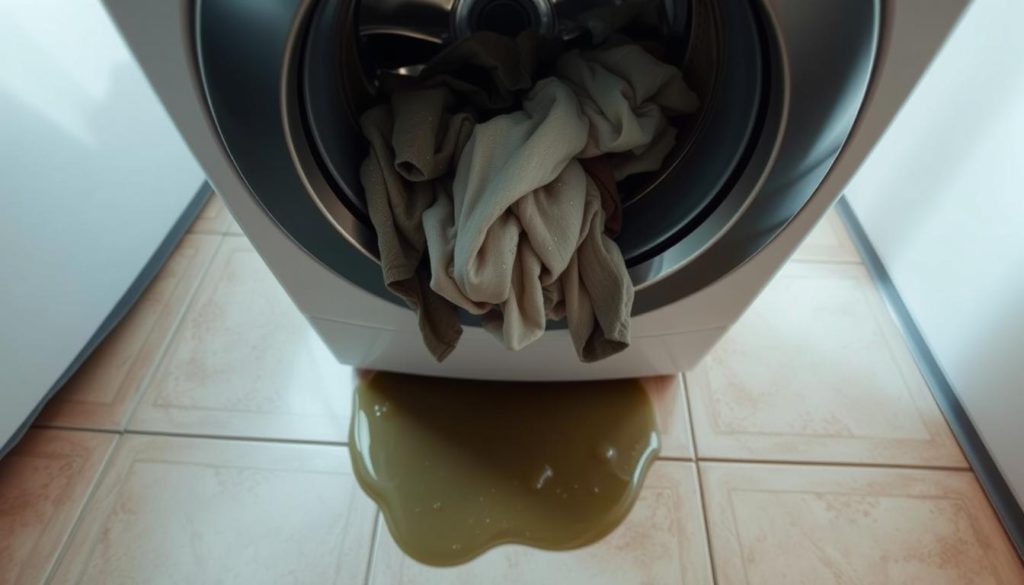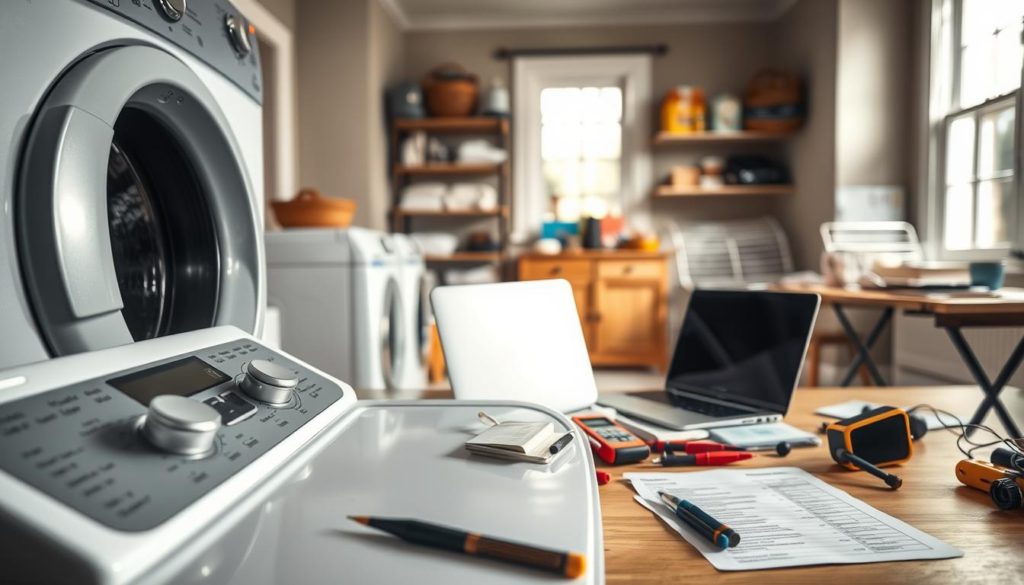What if the appliance you rely on for clean clothes is actually costing you hundreds in hidden expenses? Modern washers work tirelessly – until they don’t. Like any hardworking machine, they eventually show their age through odd noises, lukewarm performance, and mysterious puddles.
- Recognizing Wear and Age in Your Washing Machine
- 7 Signs It’s Time to Replace Your Old Washing Machine
- Listening for Unusual Noises and Vibrations
- Detecting Water Leaks and Inefficient Cleaning
- Evaluating Energy Consumption and Rising Utility Bills
- Considering Repair Costs versus Replacement
- Exploring New Washing Machine Features and Energy Efficiency
- Conclusion
- FAQ
Most units last 10-15 years, but repair bills add up quickly as components wear down. Newer models use 45% less water and 25% less energy than those from 2005, according to ENERGY STAR®. Stubborn stains that won’t budge? That’s your cue to evaluate whether your faithful laundry companion has become a financial burden.
This guide isn’t about pushing unnecessary upgrades. It’s about recognizing when patching leaks and replacing belts crosses into “money pit” territory. We’ll break down the tipping points – from erratic spin cycles to skyrocketing utility bills – so you can decide whether to repair or replace with confidence.
Key Takeaways
- Most washers lose efficiency after 10 years of regular use
- Frequent repairs often exceed 50% of a new machine’s cost
- Modern units cut water usage by nearly half compared to older models
- Persistent odors and residue signal declining cleaning power
- Unbalanced loads and loud noises indicate mechanical wear
Recognizing Wear and Age in Your Washing Machine
Your laundry routine shouldn’t feel like a gamble with every load. Machines built to last a decade often start showing strain around year eight. Repair costs spike as belts fray and pumps weaken, while efficiency drops like a forgotten spin cycle.
Observing the Appliance’s Service Life
Most units hit peak performance for 10-15 years. After that, parts like the motor or drum bearings wear down. You might notice longer wash times or lukewarm water during hot cycles. These aren’t quirks – they’re mechanical retirement notices.
Noticing Frequent Repairs and Performance Drop
Three repair calls in a year? That’s your cue to crunch numbers. New models use 45% less water than 2005-era washers, saving $100+ annually. Compare that to replacing a $200 transmission in a 12-year-old machine.
Watch for these red flags:
- Clothes emerge damp or soapy despite normal cycles
- Grinding noises during spin phases
- Vibration that shifts the unit across the floor
One repair might make sense. But when fixes outnumber clean loads monthly, your appliance’s clock is ticking louder than its unbalanced drum.
7 Signs It’s Time to Replace Your Old Washing Machine

That mysterious puddle under your laundry companion isn’t just water—it’s cash evaporating. Modern units outperform aging workhorses in both cleaning power and cost efficiency. Watch for these red flags that signal your machine’s retirement party is overdue.
Key Indicators You Shouldn’t Ignore
Persistent thumping during spin cycles often means worn drum bearings. Clothes emerging with detergent streaks or grime? Your washer’s cleaning efficiency has likely dropped below 50%. Other critical warnings include:
- Visible rust around the drum or control panel
- Error codes flashing more often than your microwave clock
- Mildew odors lingering after deep cleans
When to Weigh Repair Versus Replacement
The 50% rule applies here: if repair costs exceed half the price of a new washing machine, upgrade. A 12-year-old unit needing a $400 motor repair? That money could cover 30% of an energy-efficient model slashing utility bills.
Newer machines use precision sensors to adjust water levels per load, unlike older models that flood every cycle. If your current unit requires constant babysitting to prevent leaks or unbalanced loads, its reliability has flatlined.
Listening for Unusual Noises and Vibrations
Your laundry room shouldn’t sound like a percussion section. Modern washers operate with consistent hums and controlled spins – sudden clunks or aggressive shaking signal trouble. These disruptions often point to internal wear that worsens with each cycle.
Excessive Vibration and Loud Sounds
Persistent rattling during spin cycles often stems from worn shock absorbers or loose drum bearings. A single unbalanced load might cause temporary wobbling, but recurring vibrations indicate deeper mechanical strain. Front-load models particularly suffer from this when their suspension systems degrade.
Internal Mechanical Issues and Their Implications
Grinding noises during agitation phases suggest failing motor couplings or frayed belts. These components cost $75-$150 to replace in older machines – nearly a third of a new appliance’s price. Left unchecked, they can damage the drum shaft or transmission.
Listen for these warning sounds:
- High-pitched squealing during water intake
- Metallic clanking when reversing spin directions
- Thumping that persists after redistributing clothes
Newer models use auto-balancing technology to prevent uneven loads. If your current unit requires manual adjustments for every wash, its core mechanisms are likely compromised. Three repair visits in six months? That’s your cue to explore replacement options before a complete breakdown floods your utility room.
Detecting Water Leaks and Inefficient Cleaning

A silent leak can do more harm than a noisy breakdown. Puddles around your appliance often point to failing seals or cracked hoses, while poor stain removal hints at mechanical decline. Both issues drain resources – one through water waste, the other through rewashing cycles.
Spotting Leaks and Preventing Water Damage
Check connections behind your washer monthly. Loose inlet hoses cause 38% of household water leaks, according to insurance claims data. Look for warped flooring or discolored walls near the machine – these signal long-term moisture damage.
Common leak sources include:
- Worn door gaskets in front-load models
- Cracked drain pump housings
- Corroded water inlet valves
A single drip every two seconds wastes 1,000+ gallons yearly. Temporary fixes might stop minor leaks, but recurring issues suggest internal seal failure. When repairs exceed $300, newer models become cost-effective solutions.
Struggles with Effective Cleaning Cycles
Clothes emerging stiff or dingy? Your machine might retain soap scum or fail to agitate properly. Mineral deposits in hard water areas reduce cleaning efficiency by up to 40% over time. Front-loaders particularly suffer from mold in rubber seals.
Test cleaning performance with white towels. Persistent gray tinges or detergent residue indicate:
- Clogged detergent dispensers
- Worn wash plate teeth (top-load models)
- Failing water temperature sensors
Deep cleaning treatments provide temporary relief. When stains outlast three wash attempts, your appliance’s core functions are compromised. Newer machines with steam cycles and soil sensors often resolve these issues permanently.
Evaluating Energy Consumption and Rising Utility Bills
Your monthly utility statement might reveal more about your washing machine’s efficiency than you think. Older models guzzle resources like marathon runners at a water station – ENERGY STAR® reports show units from 2005 use 45% more water per cycle than modern equivalents.
An aging appliance’s energy demands creep upward as components degrade. Worn heating elements take longer to warm water, while loose belts force motors to work harder. These inefficiencies add $100+ to annual bills for 10-year-old machines.
Understanding Increased Water and Energy Costs
Newer models employ smart sensors and optimized wash motions that slash resource use. Compare these performance factors:
- 2005 top-loader: 40 gallons/cycle vs. 2024 model: 13 gallons
- Annual electricity costs: $65 (old) vs. $25 (new)
- Hot water usage reduction: 75% with cold-water detergents
Persistent high bills often stem from your machine’s mechanical fatigue. When monthly water usage spikes without explanation, your washer likely needs 20% more cycles to achieve mediocre results.
Monitor your utility statements for three months. If laundry-related costs climb despite unchanged habits, replacement becomes financially smarter than continued repairs. Modern units pay for their energy-saving features within 3-5 years through reduced bills.
Considering Repair Costs versus Replacement

Recurring repair bills often disguise themselves as savings. Three fixes in six months? That $75 service call fee adds up faster than detergent residue in a neglected dispenser. Modern appliances outpace their predecessors in reliability – clinging to an aging unit might drain your wallet more than upgrading.
When Fixes Outweigh Benefits
The 50% threshold rule proves crucial here. Spending $300 on a 12-year-old machine makes little sense when new models start at $600. Mechanics often call this “throwing good money after bad” – temporary solutions for terminal mechanical issues.
Consider these financial realities:
- Average repair cost: $150-$400 per incident
- New energy-efficient units save $100+ yearly on utilities
- Extended warranties often cover parts for 10 years
Frequent breakdowns signal deeper wear. Worn motors strain other components, creating a domino effect of failures. Two major repairs annually could fund 40% of a replacement appliance within three years.
Consult certified technicians for objective assessments. Many offer free estimates comparing repair quotes against new machine prices. When maintenance becomes a monthly ritual, your laundry partner has crossed from workhorse to money pit.
Exploring New Washing Machine Features and Energy Efficiency
Today’s laundry technology transforms chore into choice. Modern units deliver cleaner clothes while shrinking environmental footprints – a far cry from clunky predecessors. Let’s examine how upgraded designs balance performance with sustainability.
Advantages of Modern Energy-Saving Designs
New washers use adaptive water flow that adjusts to load sizes. Sensors detect fabric weight and soil levels, using 35% less water than fixed-volume models. ENERGY STAR® certified units slash electricity bills by $45+ annually through:
- Inverter motors reducing power spikes
- Cold-water wash optimization
- High-speed spin cycles cutting dryer time
“The average household saves 10,000 gallons yearly by upgrading to efficient models” – 2024 Appliance Efficiency Report
Enhanced Performance and Technology Upgrades
Smart features now standard in new machines include:
| Feature | Benefit | Old Models |
|---|---|---|
| Auto-dose detergent | Prevents residue | Manual measuring |
| Steam sanitize | Kills allergens | Hot water only |
| Wi-Fi diagnostics | Alerts maintenance needs | Reactive repairs |
Quiet operation (under 60 decibels) and rapid 15-minute cycles make laundry less intrusive. While older units may still function, their lack of precision often leads to rewashes and fabric damage. Investing in current technology means fewer loads, lower bills, and clothes that truly feel renewed.
Conclusion
Laundry day shouldn’t feel like a financial audit. Chronic leaks, persistent noises, and escalating utility costs reveal more than temporary glitches – they’re your washing machine’s retirement notice. Units older than a decade often drain resources through inefficient cycles and frequent breakdowns.
Key replacement indicators include:
- Repair bills exceeding 50% of a new washer’s cost
- Water pooling under the appliance after cycles
- Stubborn stains surviving multiple wash attempts
Modern machines solve these problems with smart sensors and auto-balancing drums, using 13 gallons per load versus 40 in older models. Energy-efficient designs slash monthly bills while preventing mold growth and fabric damage.
When fixes cost half the price of an upgrade, replacement becomes the smarter investment. New units pay for themselves through water savings and reduced repair needs within three years. Use this checklist to evaluate your current appliance’s performance against today’s standards.
Trust your instincts if your washer struggles through basic cycles. Upgrading protects your home from water damage while delivering cleaner clothes with every load. When laundry frustrations outweigh temporary fixes, a new machine becomes the solution your budget – and sanity – deserve.
FAQ
How long do washing machines typically last?
Most washers last 8–12 years. If yours is older, watch for frequent breakdowns, leaks, or poor cleaning. Brands like Maytag or LG often have longer lifespans, but age-related wear eventually affects all models.
Should I repair or replace a malfunctioning washer?
Compare repair costs to a new machine’s price. If repairs exceed 50% of a replacement’s cost—or issues like drum motor failure arise—it’s smarter to invest in a new energy-efficient model from brands like Samsung or Whirlpool.
What noises signal serious washer problems?
Grinding, screeching, or loud banging often point to broken belts, worn bearings, or unbalanced drums. Persistent noises during spin cycles may require professional inspection or indicate it’s time for a replacement.
Can water leaks damage my home?
Yes. Leaks from hoses, pumps, or door seals can warp floors, promote mold growth, or damage walls. Address leaks immediately. If fixes fail, consider upgrading to a leak-resistant model with features like automatic shutoff.
How does an old washer raise utility bills?
Older machines use 2–3x more water and energy per load. Look for ENERGY STAR® certified models, which cut costs by up to 25%. Modern washers also have faster spin cycles, reducing dryer time and energy use.
Are new washing machines quieter?
Yes. Brands like Bosch and GE use inverter motors and vibration-dampening tech for quieter operation. If your current machine rattles floors or disrupts household noise levels, newer designs offer noticeable improvements.
What features do modern washers offer?
New models include steam cleaning for stains, Wi-Fi connectivity for cycle tracking, and allergen-free cycles. Front-loaders from brands like Electrolux also use less detergent and water while improving stain removal.
